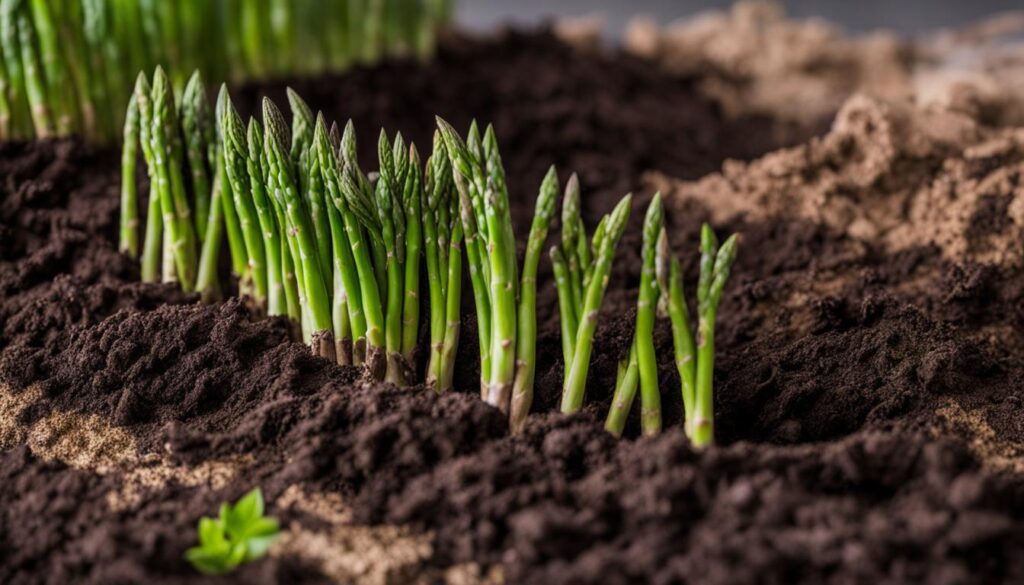Welcome to our guide on how to grow basil and asparagus together, using the power of companion planting to maximize your garden space. By strategically combining these two plants, you can create a harmonious and productive garden that not only yields a bountiful harvest but also promotes a healthy ecosystem. Whether you’re a seasoned gardener or just starting out, this article will provide you with valuable insights and tips to create a thriving asparagus companion garden.
Post Summary:- Growing basil and asparagus together through companion planting maximizes garden space and productivity.
- Basil provides food and shelter for beneficial insects while asparagus offers shade protection.
- Companion plants like cilantro, comfrey, and dill enhance the growth and health of asparagus.
- Asparagus companion planting helps repel pests, deter weeds, and attract pollinators.
- Proper planning, planting depth, and ongoing maintenance are crucial for successful asparagus companion planting.
Top Companion Plants for Asparagus
When it comes to companion planting with asparagus, there are several plants that work well together, boosting productivity and creating a harmonious garden. These companion plants not only provide additional benefits but also help to deter pests and enhance the overall health of your asparagus bed. Here are some of the top companion plants for asparagus:
Basil
Asparagus and basil make a perfect pairing in the garden. Basil has the ability to repel pests, including aphids and mosquitoes, which can be harmful to asparagus. The aromatic oils in basil also attract pollinators, such as bees and butterflies, which are beneficial for the growth of asparagus.
Cilantro
Cilantro is another great companion for asparagus. Its shallow root system allows it to coexist without competing for nutrients and space. The attractive flowers of cilantro also help to attract beneficial insects, such as ladybugs and lacewings, which feed on asparagus pests like aphids and spider mites.
Comfrey
Comfrey is a vigorous grower and can be beneficial when planted near asparagus. It attracts pollinators and provides them with a source of nectar. Additionally, comfrey’s deep roots help to improve soil quality and nutrient absorption, benefitting the growth of asparagus.
Dill
Dill is known for its pest-repellent properties and is a great companion for asparagus. It attracts beneficial insects, such as wasps and hoverflies, which prey on pests like aphids and caterpillars that can damage asparagus. The fragrant flowers of dill also add beauty to your garden.
Other plants that form symbiotic relationships with asparagus include grapes, nasturtiums, tomatoes, and parsley. These plants provide various benefits, such as pest protection, nutrient enrichment, and companion support. By incorporating these companion plants into your asparagus bed, you can boost productivity and create a thriving and diverse garden ecosystem.

Companion Plants for Asparagus
| Companion Plant | Benefits |
|---|---|
| Basil | Repels pests, attracts pollinators |
| Cilantro | Attracts beneficial insects, deters pests |
| Comfrey | Improves soil quality, attracts pollinators |
| Dill | Repels pests, attracts beneficial insects |
| Grapes | Provides shade, attracts pollinators |
| Nasturtiums | Deters pests, attracts beneficial insects |
| Tomatoes | Repels pests, enriches soil |
| Parsley | Repels pests, attracts beneficial insects |
The Benefits of Companion Planting with Asparagus
Companion planting with asparagus offers numerous benefits that can help you create a thriving and productive garden. One of the main advantages is pest prevention. By planting certain companion plants alongside asparagus, you can naturally repel pests and reduce the need for harmful pesticides. For example, tomatoes and eggplants release chemicals that repel asparagus beetles, helping to protect your asparagus crop. On the other hand, asparagus can help deter nematodes that can damage the roots of tomatoes.
In addition to pest prevention, companion planting with asparagus also provides weed suppression. When you interplant asparagus with other crops, such as beets, lettuce, or spinach, the taller asparagus fronds create shade that helps to suppress the growth of weeds. This not only saves you time and effort in weed control but also ensures that your asparagus and companion plants have access to the necessary nutrients and resources without competition from weeds.
Furthermore, companion planting with asparagus promotes a healthy ecosystem in your garden. Certain companion plants, like basil, parsley, cilantro, and dill, attract beneficial insects that help pollinate flowers and prey on pests. By providing a habitat for these beneficial insects, you can naturally control pest populations and maintain a balanced and thriving garden. Additionally, flowering plants such as marigolds and nasturtiums can attract pollinators like bees and butterflies, further enhancing the overall health and productivity of your garden.
| Benefit | Companion Plants |
|---|---|
| Pest Prevention | Tomatoes, eggplants, basil, parsley |
| Weed Suppression | Beets, lettuce, spinach |
| Enhanced Ecosystem | Basil, parsley, cilantro, dill, marigolds, nasturtiums |
The Benefits of Companion Planting with Asparagus
“Companion planting with asparagus offers a natural and sustainable way to control pests, suppress weeds, and enhance the overall health of your garden.”
In conclusion, companion planting with asparagus provides a range of benefits for your garden. From pest prevention and weed suppression to the promotion of a healthy ecosystem, asparagus companion planting can help you create a beautiful and productive garden. By choosing the right companion plants and implementing proper planting and maintenance techniques, you can maximize the potential of your asparagus crop and enjoy a bountiful harvest that is free from pests and weeds.
Planning Your Asparagus Companion Garden
When it comes to planning your asparagus companion garden, there are a few key factors to consider. One of the most important aspects is the planting arrangement. You want to choose companion plants that will not compete with the asparagus for growing space or resources. It’s also important to select plants that are compatible with asparagus and can provide mutual benefits.
Start by thinking about the height and growth habits of the companion plants. Asparagus is a tall and slow-growing plant, so it’s best to choose plants with shallow root systems that won’t interfere with its growth. Herbs like basil and parsley are excellent choices as they have small root systems and can be planted alongside asparagus without causing any issues.
Additionally, consider the compatibility of different plants. Some plants, like tomatoes and eggplants, can be planted alongside asparagus as they have similar soil and sunlight requirements. On the other hand, it’s best to avoid planting alliums like garlic and onions near asparagus as they can hinder its growth. Creating a border around your asparagus bed with flowers and herbs can also help attract pollinators and deter pests.
Companion Plant Compatibility
| Companion Plant | Benefits |
|---|---|
| Basil | Repels pests, doesn’t compete for sunlight or soil space |
| Parsley | Attracts beneficial insects, enhances garden health |
| Cilantro | Has a shallow root system, adds beauty to the asparagus bed |
| Tomatoes | Repel asparagus beetles, provide shade to asparagus |
| Marigolds | Provide pest deterrence, add color to the garden |
By carefully planning the arrangement of your asparagus companion garden and selecting compatible plants, you can create a thriving and productive garden that maximizes the benefits of companion planting. Remember to consider the height and growth habits of the plants, as well as their compatibility with asparagus. With proper planning, your asparagus companion garden will flourish and provide you with a bountiful harvest.
Tips for Successful Asparagus Companion Planting
When it comes to companion planting with asparagus, following a few key tips can help ensure a successful garden. From planting depth to ongoing maintenance, here are some guidelines to keep in mind:
Planting Depth
One important tip for asparagus companion planting is to plant the asparagus about a foot deeper than usual when interplanted with strawberries. This helps prevent competition between the roots of the two plants and allows them to thrive side by side. By following this planting depth guideline, you can create a harmonious growing environment for both asparagus and strawberries.
Ongoing Maintenance
Maintaining your asparagus companion garden involves a few key tasks. For vine crops like tomatoes and grapes, providing support such as trellises or cages is essential to keep the plants upright and prevent them from sprawling onto the ground. Additionally, vigorous growers like comfrey should be regularly pruned or contained to prevent them from overpowering other plants in the garden. By staying on top of these ongoing maintenance tasks, you can ensure that your asparagus companion garden remains healthy and productive.
Companion Plant Selection
Choosing the right companion plants is crucial for successful asparagus companion planting. Avoid planting deeply rooted plants or those that require a long time to grow, as they can disrupt the slow growth of asparagus. On the other hand, plants with shallow root systems, such as cilantro and dill, are well-suited for growing alongside asparagus. Consider the compatibility of different plants and their ability to support each other’s growth when selecting companions for your asparagus garden.
| Companion Plants | Benefits |
|---|---|
| Basil | Repels pests and attracts beneficial insects |
| Cilantro | Enhances the asparagus bed with shallow roots and attractive flowers |
| Comfrey | Provides pollinator activity and enriches the soil |
| Dill | Repels pests and attracts beneficial insects |
| Grapes | Forms a symbiotic relationship with asparagus for pest protection and nutrient enrichment |
| Nasturtiums | Offers pest deterrence and adds visual appeal |
| Tomatoes | Repel asparagus beetles and benefit from nematode deterrence provided by asparagus |
| Parsley | Attracts beneficial insects and provides aesthetic value |
By implementing these tips and selecting the right companion plants, you can create a thriving and productive asparagus companion garden. Enjoy the benefits of increased pest control, improved soil health, and a beautiful garden filled with a variety of companion plants.

Remember, successful asparagus companion planting involves careful planning and ongoing maintenance. With the right planting depth, proper maintenance techniques, and thoughtful companion plant selection, you can create a garden that not only maximizes space but also promotes the overall health and productivity of your asparagus and its companions.
Are Basil and Tomatoes Compatible with Asparagus in a Garden Setting?
When it comes to growing basil and tomatoes together in a garden setting, they can be excellent companions. Both plants thrive in similar conditions, require full sun, and benefit from regular watering. However, asparagus may not be the best match in terms of compatibility. Asparagus has different growth requirements and can be aggressive, potentially overshadowing the basil and tomatoes. It is generally recommended to separate asparagus from the other two plants for optimal growth.
Conclusion
Combining the growth of basil and asparagus through companion planting brings a multitude of benefits to your garden. The successful pairing of these two plants not only maximizes your garden space but also enhances the overall productivity and health of your plants.
By growing basil alongside asparagus, you create a natural defense system against pests. The aromatic properties of basil help repel harmful insects while providing a safe haven for beneficial ones. Asparagus, on the other hand, offers shade to protect basil from excessive sunlight, creating a harmonious environment for both plants to thrive.
Through careful planning and choosing compatible companion plants, you can further enhance the benefits of growing basil and asparagus together. Plants like tomatoes, cilantro, and dill contribute to pest prevention, while flowers such as marigolds and comfrey attract pollinators and deter pests. Asparagus companion planting not only promotes healthy growth but also helps suppress weed growth and improve soil fertility.
With the right planting depth and ongoing maintenance, your basil and asparagus companion garden will flourish. Enjoy the abundance of fresh basil and the tender shoots of asparagus while creating a stunning garden space that is both visually appealing and productive. Try this successful companion planting technique and witness the extraordinary benefits it brings to your garden.
FAQ
How can companion planting with basil and asparagus benefit my garden?
Companion planting with basil and asparagus helps attract beneficial insects, repel pests, provide shade, and maximize garden space.
What other plants can I grow alongside asparagus?
Some other companion plants that work well with asparagus include cilantro, comfrey, dill, grapes, nasturtiums, tomatoes, parsley, beets, lettuce, and spinach.
What are the benefits of companion planting with asparagus?
Companion planting with asparagus offers benefits such as pest control, nematode deterrence, enhanced pollinator activity, and the ability to interplant with cool-weather greens.
How should I plan my asparagus companion garden?
When planning your asparagus companion garden, consider the compatibility of different plants, avoid planting deeply rooted or slow-growing plants, and create borders with flowers and herbs to attract pollinators and deter pests.
What are some tips for successful asparagus companion planting?
Some tips for successful asparagus companion planting include planting asparagus deeper when interplanted with strawberries, avoiding alliums like garlic and onions, providing support for vine crops, and regular maintenance of vigorous growers.









